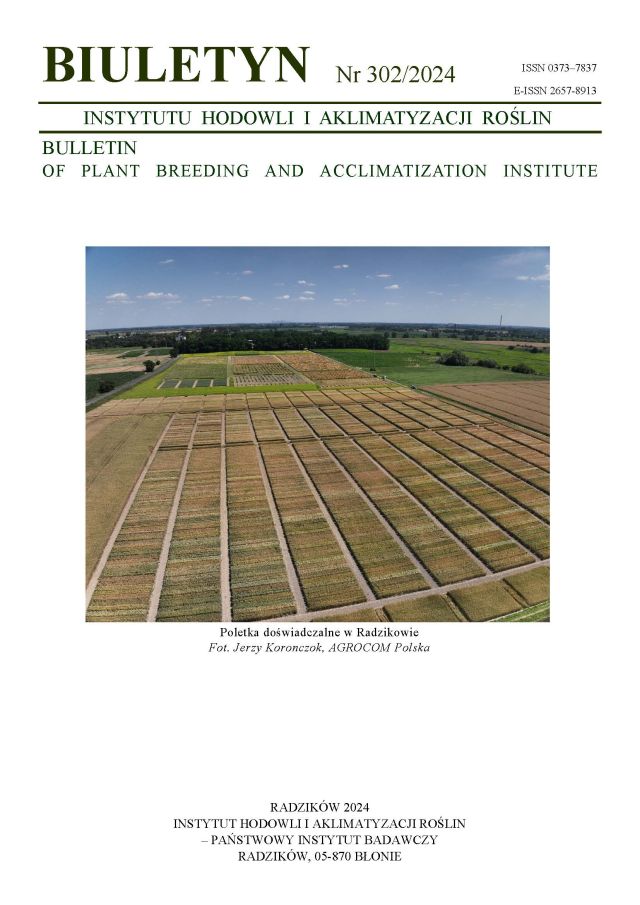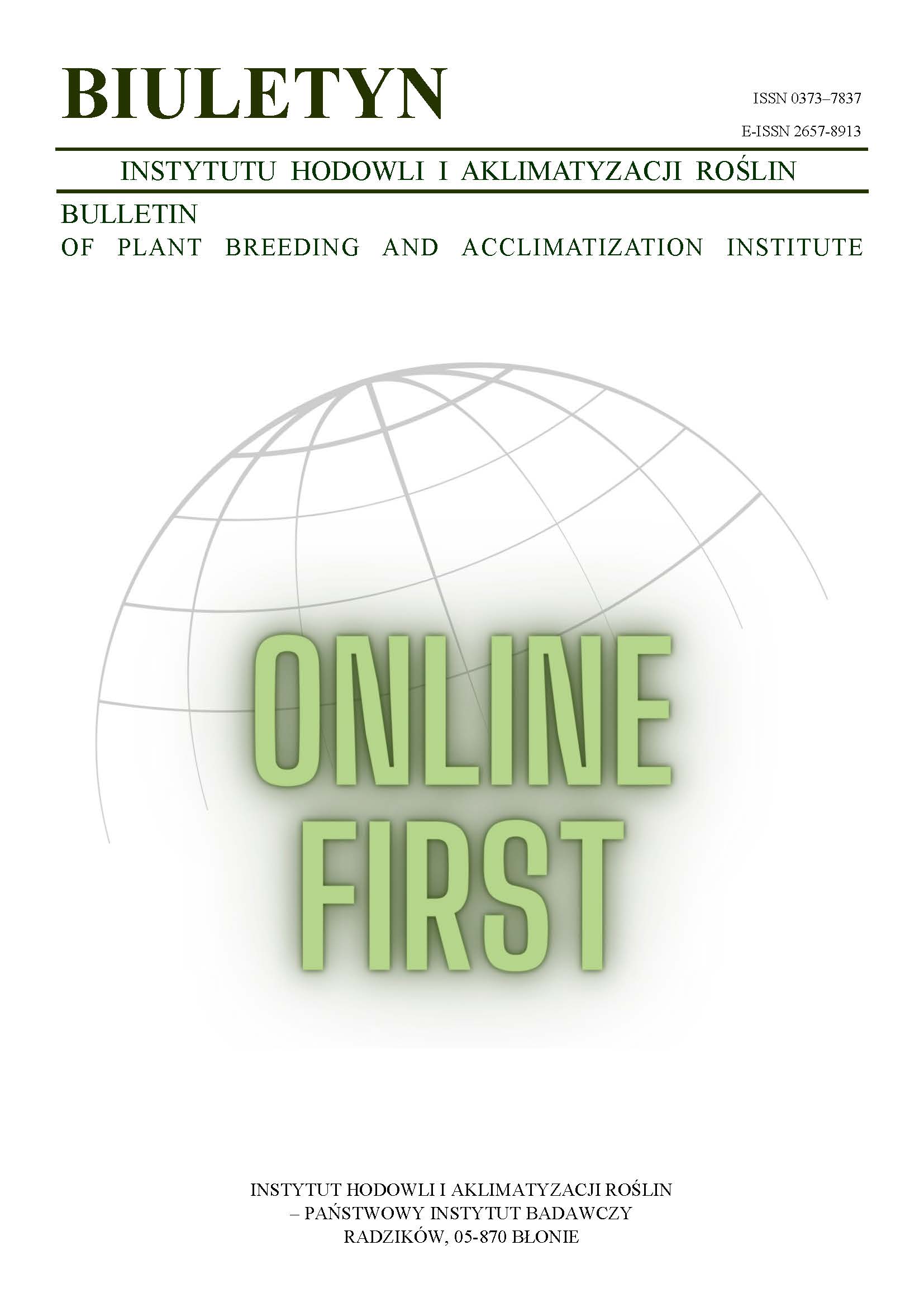Influence of various factors on the composition of fungal flora colonizing potato phyllosphere
Bożena Cwalina-Ambroziak
dziekanat.wril@uwm.edu.plKatedra Fitopatologii i Entomologii, Uniwersytet Warmińsko-Mazurski, Olsztyn (Poland)
Edward Wróbel
Katedra Produkcji Roślinnej, Uniwersytet Warmińsko-Mazurski, Olsztyn (Poland)
Abstract
The studies carried out in the years 2000–2002 comprised a precise field experiment established in Tomaszkowo in the vicinity of Olsztyn. The edible potato cultivars: Bard, Rybitwa and Wawrzyn were fertilized with different doses of nitrogen: 30, 60 and 90 kg/ha, respectively. The isolation of fungi from leaves, according to the methodology of Chruściak (1974), and from the haulm, by means of the commonly used phytopathologic method, was conducted in the laboratory to determine potato phyllosphere fungal community. The analysis of the fungal community of potato phyllosphere shows a large count and high species diversity of the fungi. The total number of isolates amounting to 10.429 was isolated from 39 species of fungi and yeast-like fungi. The yeast-like fungi constituted the most numerous group (50.5%). Among pathogenic fungi the most often isolated species were Alternaria alternata (10.9%) and Botrytis cinerea (8.8%), less frequent were fungi of the Fusarium genus (5.7%) and Colletotrichum coccodes (3.1%). Rhizoctonia solani sp. was not common — 48 colonies. Saprophytic fungi were represented by the genera Epicoccum (4.8%), Cladosporium (2.6%), Penicillium (2.4%), and the order Mucorales (5.0%). The results of the studies indicate that potato cultivars, doses of nitrogen fertilization and the time of experiment had a diversifying effect on the qualitative and quantitative composition of fungi colonies inhabiting the potato phyllosphere. The largest number of fungi colonized the Bard cultivar. The analysis of the average values of the period under study showed that the smallest number of colonies was obtained from the potato fertilized with the highest nitrogen dose 90 kg/ha. The least number of isolates was noted in the last year of the experiment which was characterized by warm and dry summer. This type of vegetation season facilitated the development of Alternaria alternata and Fusarium, whereas the number of isolates of Botrytis cinerea and Rhizoctonia solani decreased.
Keywords:
phyllosphere, fungi, nitrogen fertilization, cultivar of potatoReferences
Arx von J. A. 1970. The genera of fungi sporulating in pure culture. Verlag von J. Cramer.
Google Scholar
Blachiński D., Shtienberg D., Dinoor A., Kafkafi U., Sujkowski L. S., Zitter T. A. 1996. Influence of foliar application of nitrogen and potassium on Alternaria diseases of potato, tomato and cotton. Phytoparasitica 24, 4: 281 — 292.
DOI: https://doi.org/10.1007/BF02981411
Google Scholar
Booth T. C. 1971. The genus Fusarium. Commonwealth Mycological Institute Kew Surrey, England.
Google Scholar
Chruściak E. 1974. Mikoflora fyllosfery. Acta Myc. 10, 1: 173 — 180.
DOI: https://doi.org/10.5586/am.1974.006
Google Scholar
Cwalina-Ambroziak, Kowalska E., Gronowicz Z. 2000. Zbiorowiska grzybów fyllosfery ziemniaka w zależności od wybranych warunków agrotechnicznych. Zesz. Probl. Post. Nauk Rol. 478: 123 — 128.
Google Scholar
Czajka W., Majchrzak B., Kurowski T. 1991. Wpływ nawożenia azotem na zdrowotność przechowywanych bulw ziemniaka. Acta Acad. Agricult. Tech. Olst. Agricult. 52: 219 — 228.
Google Scholar
Elliss M. B. 1971. Dematiaceous, Hyphomycetes. CMI, KEW, Surrey.
DOI: https://doi.org/10.1079/9780851986180.0000
Google Scholar
Kermen J. 1968. Mikoflora fyllosfery. Postępy Mikrobiologii, VII, 1: 103 — 116.
Google Scholar
Kuczyńska I. 1992. Wpływ niektórych czynników na występowanie i szkodliwość alternariozy ziemniaka. Biul. Inst. Ziemn. 26: 171 — 178.
Google Scholar
Madej T. 1997. Grzyby następczo zasiedlające liście ziemniaka. Ochr. Rośl., 11: 6 — 7.
Google Scholar
Nelson P. E., Toussoun T. A., Marasas W. F. O. 1983. Fusarium species. The Pennsylvania State University Press, University Park and London.
Google Scholar
Wozniakowskaja J. M. 1962. Epiphytic yeast-organisms. Mikrobiologia 31: 616 — 622.
Google Scholar
Authors
Bożena Cwalina-Ambroziakdziekanat.wril@uwm.edu.pl
Katedra Fitopatologii i Entomologii, Uniwersytet Warmińsko-Mazurski, Olsztyn Poland
Authors
Edward WróbelKatedra Produkcji Roślinnej, Uniwersytet Warmińsko-Mazurski, Olsztyn Poland
Statistics
Abstract views: 60PDF downloads: 21
License
Copyright (c) 2004 Bożena Cwalina-Ambroziak, Edward Wróbel

This work is licensed under a Creative Commons Attribution-ShareAlike 4.0 International License.
Upon submitting the article, the Authors grant the Publisher a non-exclusive and free license to use the article for an indefinite period of time throughout the world in the following fields of use:
- Production and reproduction of copies of the article using a specific technique, including printing and digital technology.
- Placing on the market, lending or renting the original or copies of the article.
- Public performance, exhibition, display, reproduction, broadcasting and re-broadcasting, as well as making the article publicly available in such a way that everyone can access it at a place and time of their choice.
- Including the article in a collective work.
- Uploading an article in electronic form to electronic platforms or otherwise introducing an article in electronic form to the Internet or other network.
- Dissemination of the article in electronic form on the Internet or other network, in collective work as well as independently.
- Making the article available in an electronic version in such a way that everyone can access it at a place and time of their choice, in particular via the Internet.
Authors by sending a request for publication:
- They consent to the publication of the article in the journal,
- They agree to give the publication a DOI (Digital Object Identifier),
- They undertake to comply with the publishing house's code of ethics in accordance with the guidelines of the Committee on Publication Ethics (COPE), (http://ihar.edu.pl/biblioteka_i_wydawnictwa.php),
- They consent to the articles being made available in electronic form under the CC BY-SA 4.0 license, in open access,
- They agree to send article metadata to commercial and non-commercial journal indexing databases.
Most read articles by the same author(s)
- Małgorzata Gołębiewska, Edward Wróbel, The effect of nitrogen fertilization on yielding of maize , Bulletin of Plant Breeding and Acclimatization Institute: No. 251 (2009): Regular issue
- Małgorzata Gołębiewska, Edward Wróbel, Effect of nitrogen fertilization on yield and quality of whole maize plants for silage , Bulletin of Plant Breeding and Acclimatization Institute: No. 256 (2010): Regular issue
- Bożena Cwalina-Ambroziak, Bożena Bogucka, Aldona Trojak, Infestation of some potato cultivars by Colletotrichum coccodes (Wallr.) Hughes at different levels of nitrogen fertilization , Bulletin of Plant Breeding and Acclimatization Institute: No. 246 (2007): Regular issue
- Edward Wróbel, Tadeusz Krajewski, Wojciech Krajewski, The effect of nitrogen application on yield and its structure of naked and hulled oats , Bulletin of Plant Breeding and Acclimatization Institute: No. 229 (2003): Special issue
- Bożena Cwalina-Ambroziak, Edward Wróbel, Influence of nitrogen fertilization on the occurrence of important diseases on potato tubers , Bulletin of Plant Breeding and Acclimatization Institute: No. 237/238 (2005): Regular issue
- Edward Wróbel, Tadeusz Krajewski, Marek Krajewski, Yield and fodder value of naked oats grain in pure sowing and in mixtures , Bulletin of Plant Breeding and Acclimatization Institute: No. 229 (2003): Special issue














